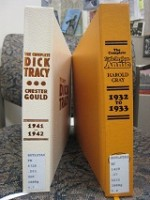I’ve been doing research recently on Lynd Ward (whose wordless woodcut novels were just published by the Library of America). I found a trove of New York Times reviews of these early books—they all appeared between 1929 and 1937—and in each, the reviewer has a hard time taking the material seriously. Take, for instance, a 1933 Times review of Prelude to a Million Years. The review is by John Chamberlain, a syndicated columnist and book critic.
What the ‘reader’ will make of a series of woodcuts which tell this story is conjectural. For our own part, we wish Mr. Ward would employ his dexterity in catching shades of emotion in the illustration of other people’s written stories. The art of painting, or of the woodcut, by its very static nature, is not a good medium for drama, which must march. It is a platitude, of course, to say this, but the platitude has not yet convinced Mr. Ward.
Aside from the laughable “critical” faculties at work here, it’s interesting that the idea of pictures standing in for words seems such a difficult concept to grasp. Chamberlain feels that pictures in books are for illustration; they are secondary to the words and ought to play a supporting role. What might he have said of a comic book, in which words and pictures work together, often on equal footing?
The reviewer’s small-minded conception of the medium makes this quote by Ward, part of his 1953 Caldecott acceptance speech, in which he so succinctly describes what comics alone can do, all the better:
No other medium in which the artist can work has that particular element to offer, and it is that one thing that makes the book a form something different for the artist from what it is for the writer. It is true that the writer works with a succession of words, paragraphs and chapters that because of their sequence in time have a significance completely dependent upon that time sequence; but the turning of the page is not essential to that sequence, and, save at the end of the chapter, is more often than not likely to be an interruption that is tolerated rather than utilized for its own sake. For the artist, however, the turning of the page is the thing he has that no other worker in the visual artist has: the power to control a succession of images in time, so that the cumulative effect upon the viewer is the result of not only what images are thrown at him, but the order in which they come. Thus the significance of those coming late in the sequence is built up by what comes earlier.









 I just sat down and re-read thru the new Love and Rockets issue. Shame on you, True Believer, if you haven’t already dog-eared this one. Please, please order this one today and thank me for urging you to do so. As
I just sat down and re-read thru the new Love and Rockets issue. Shame on you, True Believer, if you haven’t already dog-eared this one. Please, please order this one today and thank me for urging you to do so. As 




